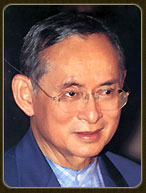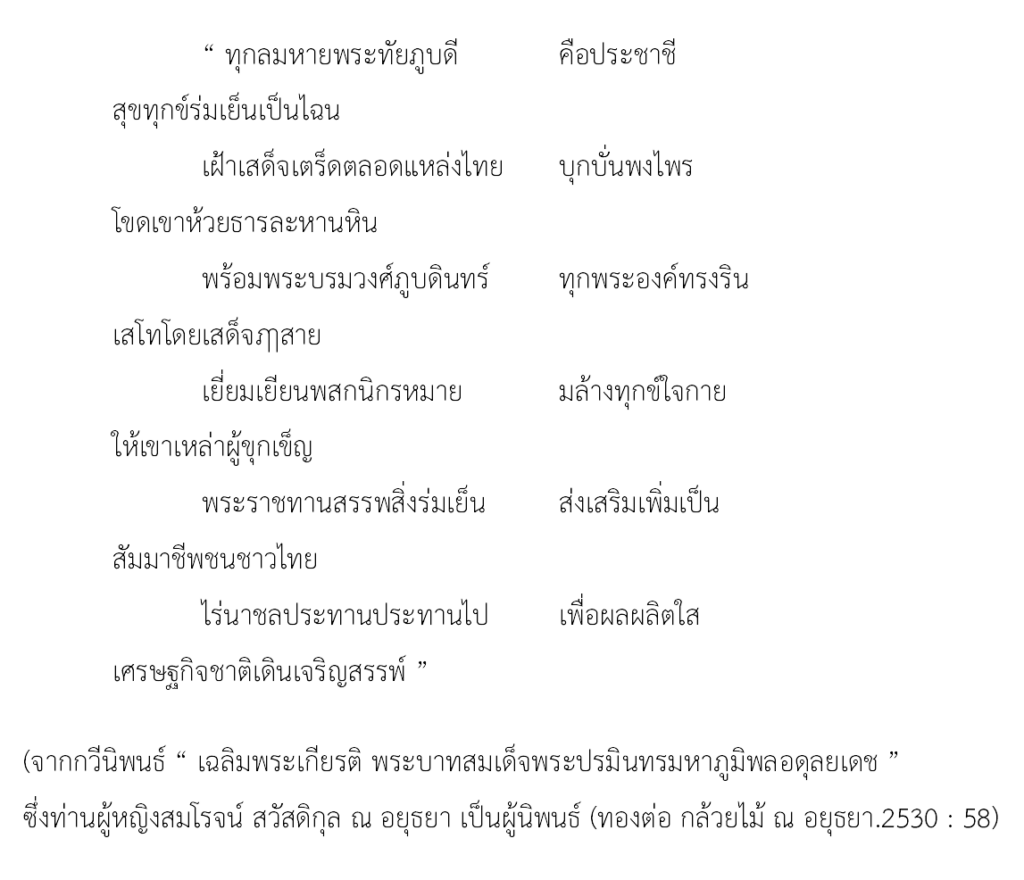His Majesty King Bhumibol Adulyadej The Great
Chapter 6: Royal Visits to Citizens Across the Provinces of the Country
The first major royal duty that was of primary importance and considered a principal responsibility was the Royal Visits to the citizens. King Bhumibol Adulyadej of Thailand was determined in his heart to visit his people throughout the country before making any foreign visits in response to invitations. Accordingly, in September 1955, he undertook visits to citizens in the central provinces, both by land and water. Subsequently, he visited the northeastern region for the first time, traveling by train from Chitralada Station to various provinces, where large crowds of citizens gathered to pay their respects and demonstrate their loyalty.
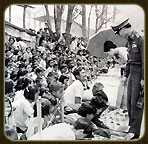
He made Royal Visits to the people in the northeastern region.

Chitralada Railway Station

One particularly touching incident occurred as the train moved along: an elderly couple hurriedly brought sticky rice and fermented fish to present to His Majesty, saying, “Seeing that our father and mother will travel by train, we feared they might have nothing to eat along the way, so we brought this for you.” This demonstrated the admirable kindness of the people of Isan, who cared deeply for His Majesty, just as He cared for them.
In Ubon Ratchathani Province, a reception ceremony was held at Thung Si Mueang, featuring a nine-tiered bai sri su kwan arrangement. This event was considered the grandest in history and included a presentation of royal blessings in the local dialect, reflecting the traditional cultural heritage of the region.
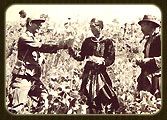
Visiting the hill tribe people
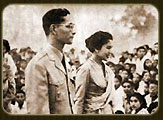
He made a royal visit to Chiang Mai.
Even in dangerous areas, He proceeded, such as in Thung Chang District, Nan Province, where fighting was occurring at the time. Border patrol police had been surrounded and injured. He graciously ordered a helicopter to evacuate the wounded. Just as He was about to have His packed lunch, the sound of the helicopter bringing the injured filled the air. He immediately postponed His meal and went to receive them. When Her Majesty the Queen observed the soldiers’ dry, chapped lips, she showed compassion for their suffering and peeled oranges to feed the wounded soldiers. This act deeply touched both the injured soldiers and all those who witnessed the scene.
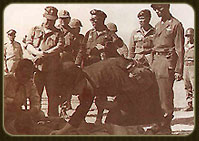
Her Majesty the Queen peeled oranges and personally fed them to the wounded soldiers.
During His visits to the southern region, from Chumphon to the far south, He visited the people and important sites. For example, in Pattani Province, He sat on the throne to review cases at the provincial court and visited mosques of Thai Muslims. In some places, He sat as an honor in the mosque upon invitation. Wherever He went, some people asked to kiss His hand, others asked to dip His hand into a bowl. On one occasion, a villager requested that the King place His feet on his head, and another made a similar request. King Rama IX humorously responded, asking, “Then how could I stand?”
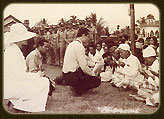
Visited the people in the southern region
This demonstrates the deep loyalty and reverence the people have for His Majesty, reflecting his noble character and compassionate heart toward the populace.
He has always cared for the well-being of his people. Whenever citizens face disasters, such as floods or severe storms, causing great loss, he has shown concern by providing essential supplies, food, clothing, and medicine to console and encourage those affected. On some occasions, he personally visited the affected areas. This benevolence has served as a true source of moral support. During visits, he would graciously arrange for volunteer doctors to accompany him, provide medical care, distribute medicine, and sometimes take certain patients under his royal patronage.
His Majesty King Rama IX, Her Majesty the Queen Mother, and other members of the royal family have consistently visited provinces in the North, East, and South. Each year, His Majesty devotedly spent at least eight months visiting the people, both officially and unofficially. It is understood that his relocations to different regions were for the sole purpose of visiting his people. Today, royal residences exist in various provinces, such as Phuping Palace in Chiang Mai, Phu Phan Palace in Sakon Nakhon, Taksin Ratchaniwet Palace in Narathiwat, and Klai Kangwon Palace in Hua Hin, Prachuap Khiri Khan.

Phuping Rajanivet Palace, Chiang Mai Province

Thaksin Ratchaniwet Palace, Narathiwat Province

Phu Phan Ratchaniwet Palace, Sakon Nakhon Province

Klai Kangwon Palace, Prachuap Khiri Khan Province
This was so that His Majesty could be closely aware of the joys and sorrows of the people, an unparalleled act of royal benevolence.
Mom Luang Thawisan Ladawan, a royal secretary, delivered a special lecture on November 18, 1986, at the Information Auditorium, Chulalongkorn University, stating:
His Majesty traveled to meet and mingle with the people, providing immediate assistance to address local problems. This practice began in 1952, starting in the central region. As far as I recall, the provinces of Uthai Thani…
Afterwards, His Majesty traveled to the northeastern region and then to other regions in succession. This was regarded as an important royal policy and intention: to reside or temporarily relocate to various provinces as much as possible, in order to help solve the problems of rural citizens. Sometimes, this created challenges for the duties of the royal secretaries. If His Majesty enjoyed good health—meaning no illness or major royal engagements—He would reside in the provinces for seven to eight months a year. Remarkably, according to records, His Majesty traveled tens of thousands of kilometers annually because He saw the importance of helping impoverished rural Thais as much and as quickly as possible. This created some difficulty for the royal secretaries, as there were still many royal duties in Bangkok that could not be accommodated within the schedule there.
For instance, the granting of university degrees each year, especially with the increasing number of universities and students, required solutions. Ultimately, His Majesty would graciously allow royal princes and princesses to represent Him in these ceremonies.
Traveling to visit rural citizens in the provinces was considered a principal royal duty. It included both official visits to projects initiated by royal initiatives and attending ceremonies in provinces that formally invited His Majesty. Usually, ceremonial invitations were accepted only when opportunities allowed. Most of the time was devoted to inspecting and visiting royal projects. Visiting the people provided opportunities to observe the conditions and living standards of the populace. Most visits were private, but in some cases, officials would coordinate appropriately, based on information collected from official requests for royal visits from various government agencies. For other destinations, His Majesty sometimes determined them independently, visiting points without prior notice to officials, as a precautionary measure, which was occasionally done.
“… On every occasion of visiting the people, His Majesty the King would study the situation in advance. He would examine the terrain, as well as the difficulties and problems experienced by the local population, and draft a preliminary development plan. Upon observing the actual conditions, He would adjust the plan to make it appropriate. His Majesty would observe the geography, living conditions, water sources, transportation routes, agricultural areas, and forests along the way. Upon arrival, He would engage in royal interactions with the local people, especially those knowledgeable about the area, as well as local officials. If problems concerning the livelihoods of the people were identified, or if petitions were presented, He would personally visit the affected areas and then give guidance to development and security officials on how to plan solutions. Petitions presented to Him would be received and referred to the relevant government agencies for consideration in line with His royal directives before assistance was provided as appropriate…”
“… His Majesty’s visits to rural areas were to observe the actual conditions on site. He would carefully review preliminary information obtained through interactions with local people. Observing the problems firsthand, along with statistical data, reports from development officials, and petitions from the people, allowed Him to plan effectively. On some occasions, officials involved in development would be summoned to report and receive additional royal guidance for implementation and periodic reporting. Normally, His Majesty would follow up on projects in the field, monitor progress, and address obstacles until the projects began to take shape. He developed expertise in planning using maps and aerial photographs, constantly verifying their accuracy against actual conditions. Being close to the people allowed Him to obtain accurate information. For example, when the Royal Irrigation Department submitted a report on constructing small dams in the northern region, His Majesty examined the maps and questioned whether construction was feasible. Upon asking villagers from the area, they confirmed that the dam could not be built effectively, as the lower ground consisted of sand and would not retain water.”
“This demonstrates the value of His Majesty’s visits to the people and staying in the field for extended periods. As seen on television, He would sit or lie on the ground, spread out maps, and consult directly with the people to obtain accurate and truthful information. He did not rely solely on reports from government agencies, because all projects were created using national funds. Therefore, everything had to be carried out with great care and meticulous attention to detail.”

he would question the villagers in order to obtain accurate and reliable information.
On occasions when His Majesty King Rama IX visited projects, inspected the terrain, or observed water sources, Her Majesty the Queen Mother would often separate from the main procession to visit the people. She would inquire about their living conditions, including occupations, public health, and children’s education. She would also accept villagers who voluntarily joined the Special Arts and Crafts program, allowing them to produce works according to their skills, which would then be sent to Suan Chitralada for the foundation to manage and sell. Alternatively, they could travel to train in arts and crafts at the royal residence in that region.
At each royal residence, there was a vocational training center of the Silpa Bhirasri Foundation, where participants received remuneration for their training, as well as food and accommodation. After His Majesty King Bhumibol Adulyadej completed his development and project planning duties, he would join the procession of Her Majesty the Queen Mother at the designated locations for visiting the people, and upon finishing the royal duties, they would return together.
The time of return to the royal residence was not fixed, depending entirely on the royal duties and the condition of the transportation routes, some of which were very remote. It is worth noting that sometimes the return occurred as late as 2 a.m. It is well known that at times, His Majesty could not have his midday meal until around 4 p.m. Those who accompanied him, like myself, sometimes had to carry sweets, but generally the ladies-in-waiting or female royal attendants carried food in their bags and graciously offered us some to tide us over. Indeed, all the royal personages displayed great endurance. As I mentioned earlier, His Majesty exhibited remarkable self-sacrifice and patience.
On some occasions, the journeys required traveling through forests. For example, during visits to the southern provinces, His Majesty traversed marshy lands and areas infested with leeches and ticks, which posed significant challenges. When the King of Malaysia, known as Agong, visited Thailand on an official visit, he advised that when going through leech-infested areas, one should go first so that the leeches would not attack. However, the Thai leeches proved to be far more persistent. His Majesty dressed carefully and applied balm, which proved even more effective than the Agong’s advice.
Even when His Majesty reached the age of seventy-seven on December 5, 2004—a stage considered elderly and deserving of rest—he continued to tirelessly travel to visit local communities. He faced rain, leeches, and other insects, all to guide the underprivileged in their struggle against poverty, illness, and lack of education. His royal duties, undertaken for the benefit of the nation, are unparalleled and comparable to those of past great kings, including the revered King Chulalongkorn, who brought immense benefit and love to the Thai people.
Thus, the people collectively bestowed upon Him the honorary title of “Maharaj” of Thailand. Deeply moved by His boundless royal benevolence, the Thai people earnestly prayed, invoking the Triple Gem and all sacred powers throughout the universe, to protect His Majesty King Bhumibol Adulyadej, granting Him long life, enduring happiness, and remaining forever the cherished inspiration and guiding light for all Thai subjects.
